Tribute to a Long Summer
With daily temperatures now in the mid 20's, we can finally declare this year's summer at an end. What a long, hot, stable summer it was (our rough two weeks in Okinawa being the sole exception, isolated both in time and space). Let us pay a tribute to it with this fairly random collection of pictures and thoughts.
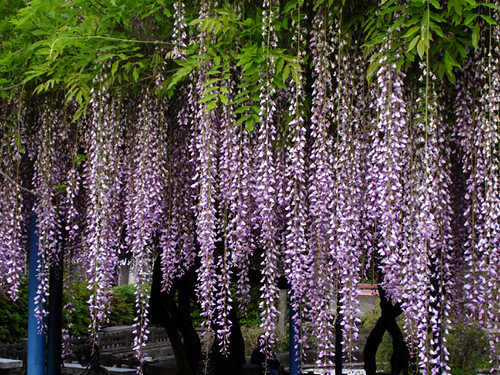
This is Wisteria, a vine ubiquitously cultivated on dedicated trellises at parks across the country. It blooms in May, typifying a warm, brief, uncertain spell between spring and the rainy month of June. The Japanese are truly obsessed with such seasonal changes and prehaps that's why this plant, which also grows wild in the mountains, has become one of the few chosen wild plants to be loved. Its kanji character, read as 'fuji' (distinct from the famous mountain) or 'tou', also appears rather frequently in Japanese surnames, especially those with samurai heritage.

For Golden Week holiday in May, we went rock climbing to Hachimenzan, in north-east Kyushu, having cancelled our more ambitious trip to Horai near Nagoya due to a dismal weather forecast and various tendon injuries from having climbed 5.12 a few times too often in the preceeding weeks. With wrecked bodies, and nearly daily rain, we did not accomplish too much here either but we had a fun, relaxing time anyway, camping in the nearby, newly built, but evidently not often used, roofed-over open-air amphitheater.
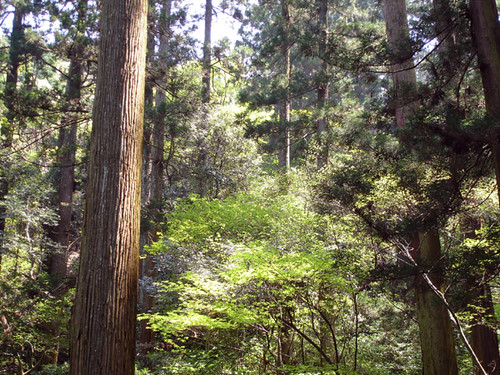
Japan has a long record of carefully coordinated forestry. This fairytale forest in Oomura, Nagasaki Prefecture, close to our 'home' climbing crag Nodake, is actually the end result of a cedar plantation started more than 15o years ago but somehow never harvested. Although forestry efforts have run amok since the post-war era (too much monoculture, erosion and runoff problems, not enough maintenace, insufficient demand for expensive domestic lumber), walking through this place suggests a forgotten era of more common sense and a better balance with nature.

Late May saw the Sea Kayak Academy, a general meeting of Japanese sea kayakers, taking place for the first time in our home islands of Amakusa. While the background in this picture could not be more artificial (look closely and you can even see a coal burning power plant), the Academy is more about education, information, and equipment than touring. Even the two of us gave some lectures and talks, which seemed well received in spite of our funny Japanese.
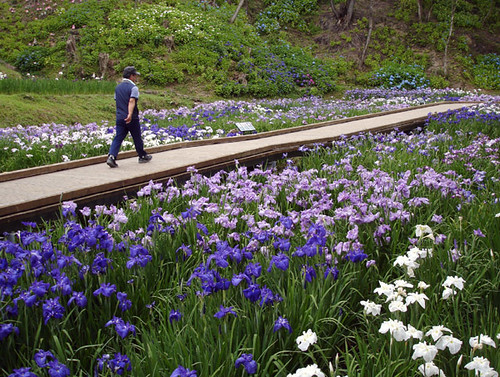
One of the best things that has recently happened to our home town of Hondo (now actually Amakusa City) is the establishment of Nishinokubo Park, an extensive public facility encompassing an entire small valley in the hills on the outskirts of town. Where before there was only a swampy reservoir and half-forgotten, overgrown rice paddies, today the new park has become incredibly popular, with the Iris Festival in June as its yearly zenith. Citizens using the park's boardwalks for exercise could hardly ask for better surroundings.
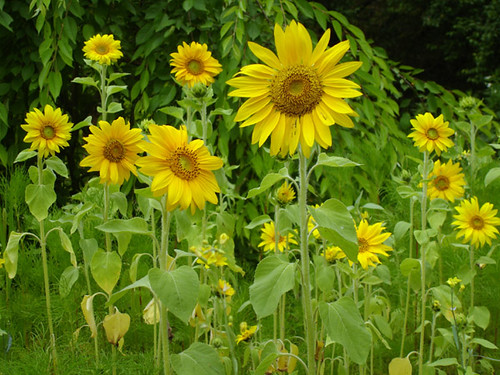
Sunflowers at Nishinokubo also announce the arrival of summer.

This extremely tenacious species of fern covers nearly all hillsides in Amakusa. The dense tangle of fronds can reach depths of over one's head, making bushwhacking to reach a trail-less summit a truly masochistic experience. It is one of the few plants able to form an undergrowth in the ubiquitous cedar and cypress plantations, and in drier places it can choke out even trees, becoming the main groundcover in light green patches visible from afar. In early summer the fresh fronds look particularly attractive due to their delicate color and geometric beauty.
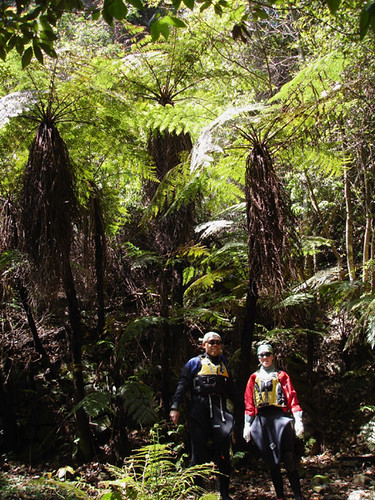
Another species of fern called 'Hego' , actually is a tree. It is a subtropical species, and forests of it are common in the Southwest Archipelago. Here in Amakusa it is at its northern limit of distribution and only grows in patches in one tiny valley near the sea which seems to be the only local place that can provide the needed moisture, light, and protection from frosts. Leanne and our friend Nishikawa paid a visit by kayak, walking in from a nearby beach.

The west coast of Amakusa between Yokaku and Oniki bays is our favorite local stretch of coast. Imposing cliffs riddled here and there with caves, rock pinnacles, sunken boulders, isolated beaches, and scarcely a sign of human presence make this 10km stretch rather special. Though we know its every nook and cranny by now, we often come here 'for a stroll' among the quiet sounds of the water and the cries of sea birds nesting in the cliffs.

Fukumado is Amakusa's longest and largest sea cave (about 150m long, and large enough to accept a fishing boat). Here Nishikawa and Leanne lounge around at its entrance while Rick (taking picture) psyches up for the 10m plunge into deep water below.
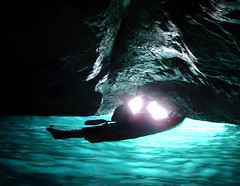
Another nearby cave has several entrances, including one that is completely submerged at high tide. Kayakers can enjoy the delightful effect of a turquoise glow illuminating the cave from underneath.
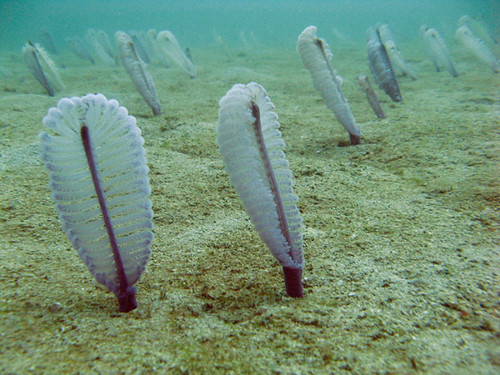
Exploring Amakusa's shores by snorkel is one thing we tell ourselves we should do more often. Many subtropical species of creatures can be found here, and their number is increasing yearly due to global warming. Here, what may be a species of worm living in the sandy bottom, filters plankton out of the flowing current.
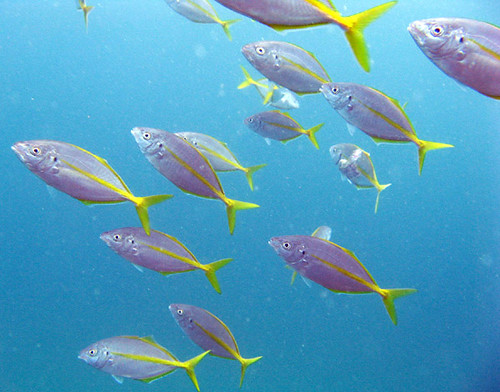
These colorful fish seemed to want their picture taken, schooling and swimming in circles around me. Though not as bewildering as in Okinawa, Amakusa does have a cornucopia of marine fish species. We were able to identify this one as young Pseudocaranx dentex (Shima-aji in Japanese).

In September, heat and bright sunshine continued unrelentingly. We had the happy opportunity to paddle with Mrs. Chiba, a kayaker on an extended solo trip, roving around Japan in her van. We introduced her to one of our favorite day-trips: the traverse to Yushima. After a smooth 2-hour open-sea paddle, we entered the quaint Yushima port and village.

Chiba-san enjoys a sunset view of Yushima, the Ariake Sea, and Amakusa Kami-shima from the top of Yushima's water tower. Tidal conditions dictated a night paddle on the return, but with a bright moon and calm seas, this too was highly enjoyable. Chiba-san has accumulated a lot of experience on her trips: she is one of the few people we know who paddle as much or more than we do! It was a pleasure to chill with someone in that special frame of mind only an extended road trip can bring. Oh, what luxury!

This is Wisteria, a vine ubiquitously cultivated on dedicated trellises at parks across the country. It blooms in May, typifying a warm, brief, uncertain spell between spring and the rainy month of June. The Japanese are truly obsessed with such seasonal changes and prehaps that's why this plant, which also grows wild in the mountains, has become one of the few chosen wild plants to be loved. Its kanji character, read as 'fuji' (distinct from the famous mountain) or 'tou', also appears rather frequently in Japanese surnames, especially those with samurai heritage.

For Golden Week holiday in May, we went rock climbing to Hachimenzan, in north-east Kyushu, having cancelled our more ambitious trip to Horai near Nagoya due to a dismal weather forecast and various tendon injuries from having climbed 5.12 a few times too often in the preceeding weeks. With wrecked bodies, and nearly daily rain, we did not accomplish too much here either but we had a fun, relaxing time anyway, camping in the nearby, newly built, but evidently not often used, roofed-over open-air amphitheater.

Japan has a long record of carefully coordinated forestry. This fairytale forest in Oomura, Nagasaki Prefecture, close to our 'home' climbing crag Nodake, is actually the end result of a cedar plantation started more than 15o years ago but somehow never harvested. Although forestry efforts have run amok since the post-war era (too much monoculture, erosion and runoff problems, not enough maintenace, insufficient demand for expensive domestic lumber), walking through this place suggests a forgotten era of more common sense and a better balance with nature.

Late May saw the Sea Kayak Academy, a general meeting of Japanese sea kayakers, taking place for the first time in our home islands of Amakusa. While the background in this picture could not be more artificial (look closely and you can even see a coal burning power plant), the Academy is more about education, information, and equipment than touring. Even the two of us gave some lectures and talks, which seemed well received in spite of our funny Japanese.

One of the best things that has recently happened to our home town of Hondo (now actually Amakusa City) is the establishment of Nishinokubo Park, an extensive public facility encompassing an entire small valley in the hills on the outskirts of town. Where before there was only a swampy reservoir and half-forgotten, overgrown rice paddies, today the new park has become incredibly popular, with the Iris Festival in June as its yearly zenith. Citizens using the park's boardwalks for exercise could hardly ask for better surroundings.

Sunflowers at Nishinokubo also announce the arrival of summer.

This extremely tenacious species of fern covers nearly all hillsides in Amakusa. The dense tangle of fronds can reach depths of over one's head, making bushwhacking to reach a trail-less summit a truly masochistic experience. It is one of the few plants able to form an undergrowth in the ubiquitous cedar and cypress plantations, and in drier places it can choke out even trees, becoming the main groundcover in light green patches visible from afar. In early summer the fresh fronds look particularly attractive due to their delicate color and geometric beauty.

Another species of fern called 'Hego' , actually is a tree. It is a subtropical species, and forests of it are common in the Southwest Archipelago. Here in Amakusa it is at its northern limit of distribution and only grows in patches in one tiny valley near the sea which seems to be the only local place that can provide the needed moisture, light, and protection from frosts. Leanne and our friend Nishikawa paid a visit by kayak, walking in from a nearby beach.

The west coast of Amakusa between Yokaku and Oniki bays is our favorite local stretch of coast. Imposing cliffs riddled here and there with caves, rock pinnacles, sunken boulders, isolated beaches, and scarcely a sign of human presence make this 10km stretch rather special. Though we know its every nook and cranny by now, we often come here 'for a stroll' among the quiet sounds of the water and the cries of sea birds nesting in the cliffs.

Fukumado is Amakusa's longest and largest sea cave (about 150m long, and large enough to accept a fishing boat). Here Nishikawa and Leanne lounge around at its entrance while Rick (taking picture) psyches up for the 10m plunge into deep water below.

Another nearby cave has several entrances, including one that is completely submerged at high tide. Kayakers can enjoy the delightful effect of a turquoise glow illuminating the cave from underneath.

Exploring Amakusa's shores by snorkel is one thing we tell ourselves we should do more often. Many subtropical species of creatures can be found here, and their number is increasing yearly due to global warming. Here, what may be a species of worm living in the sandy bottom, filters plankton out of the flowing current.

These colorful fish seemed to want their picture taken, schooling and swimming in circles around me. Though not as bewildering as in Okinawa, Amakusa does have a cornucopia of marine fish species. We were able to identify this one as young Pseudocaranx dentex (Shima-aji in Japanese).

In September, heat and bright sunshine continued unrelentingly. We had the happy opportunity to paddle with Mrs. Chiba, a kayaker on an extended solo trip, roving around Japan in her van. We introduced her to one of our favorite day-trips: the traverse to Yushima. After a smooth 2-hour open-sea paddle, we entered the quaint Yushima port and village.

Chiba-san enjoys a sunset view of Yushima, the Ariake Sea, and Amakusa Kami-shima from the top of Yushima's water tower. Tidal conditions dictated a night paddle on the return, but with a bright moon and calm seas, this too was highly enjoyable. Chiba-san has accumulated a lot of experience on her trips: she is one of the few people we know who paddle as much or more than we do! It was a pleasure to chill with someone in that special frame of mind only an extended road trip can bring. Oh, what luxury!


0 Comments:
Post a Comment
<< Home